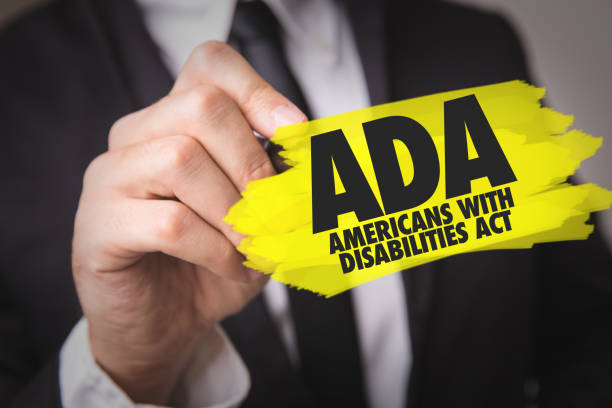
The Americans with Disabilities Act (ADA) serves as the gold standard of accessibility in the United States, with nearly every public and private business operating under its guidelines. All companies that serve or employ individuals other than their owners must follow ADA requirements to ensure accessibility for all individuals – including those who have visual or hearing impairments, learning or cognitive disabilities, or physical disabilities such as wheelchair use and paralysis. Here are the five most essential ADA requirements on tactile warning surfaces that every business must know about, regardless of their size, location, or clientele.
1. They Must be Detectable by a Long Cane or Underfoot
Tactile warning surfaces must be detectable by a long cane or underfoot. That ensures that they are accessible to those who are blind, visually impaired, and have low vision. It’s an essential requirement because individuals with disabilities rely on canes or other mobility devices to get around safely. For example, visually impaired individuals might use a long white rod with a red tip as their primary means of navigation in public spaces.
When these people encounter tactile warning surfaces, they will know that there is something in their path and what it is (for example, a stairway) to avoid it if necessary. Quality warning surfaces like black truncated domes are easy to spot with a cane or foot. The material should be at least 0.9 inches high; anything less than that height may not be detectable by a person using a mobility device such as a wheelchair, walker, crutches, or cane.
2. They Must Have a Certain Texture and Contrast.
The tactile warning surfaces must be able to attract attention by contrasting their surroundings. They need to be at least 48 inches (1.2 meters) in length and 60 inches (1.5 meters) in width, with a truncated domed or crater pattern with a diameter of at least 1⁄2 inch. They need to distinguish from their surroundings, so people can quickly identify them either by sight or touch.
It must contrast visually with adjacent walking/working surfaces to ensure visibility under normal lighting conditions. They must provide tactile guidance to direct pedestrians with disabilities away from hazards or toward accessible routes and elements, including vertical accesses such as ramps, curb ramps, or blended transitions; parking spaces reserved for people with disabilities; accessible doorways; detectable warnings at pedestrian pathway transitions; and detectable warnings on medians where provided.
3. They’re Suitable for Raised Surfaces Near Drop-Offs.
The ADA recognizes that blind or visually impaired people may have difficulty sensing when approaching a drop-off. That’s why raised surfaces with edges that are neither rounded nor abrupt (like a long set of steps) in public places must have tactile warning systems. To be considered compliant, these tactile surfaces need to be at least an inch tall and no more than four inches high.
Tactile warning surfaces also need to follow specific patterns depending on whether they are truncated domes, rectangular domes, or any other detectable design through touch and sight. That is because it’s not enough for these surfaces to meet ADA requirements—they also need to be easy for those who use them regularly to recognize.
4. The Corners and Edges Cannot be Sharp or Snag on Clothing or Skin
Sharp or jagged edges can cause lacerations. Hence, many tactile warning surfaces are made with rounded or half-inch beveled edges to prevent injury. The surface edges must be thick enough to avoid cuts and scratches when running your hand along with them. That will ensure you don’t get injuries if you have to run across one quickly.
Also, they must present in areas where there is a high risk of tripping and falling: Tactile warning surfaces are suitable in areas where there is an increased risk of tripping and falling, such as stairways, curbs, and walkways.
5. They Need to Be Slip Resistant and Non-Slip
Slip resistance refers to how well a surface holds onto shoes, clothing, and other objects on top of it so that people don’t slip on it while walking across it. Non-slip refers to how well an object keeps its position on top of another entity without slipping off quickly. That is important in tactile warning surfaces because if they aren’t non-slip, they won’t be able to keep everyone safe effectively.
Tactile warning surfaces need to have different textures: Tactile warning surfaces are made up of different textures or patterns so that blind or visually impaired individuals can feel them with their feet when walking over them. It helps them know where stairs or drop-offs are ahead of time to avoid injury from tripping or falling stairs unexpectedly. The surface area must be firm, stable, non-slip, and free of any materials that would damage footwear or wheels used by pedestrians with disabilities.
Conclusion
Businesses are responsible for maintaining a safe, accessible environment for all consumers. Know the rules and take care of the necessary corrections to ensure compliance. Tactile warning surfaces are an essential part of maintaining a safe business environment. The Americans with Disabilities Act (ADA) has specific requirements that you’ve to meet to comply with Title III guidelines regarding tactile warning surfaces in public facilities. Suppose you’re looking to open a new business or improve an existing one. In that case, it’s essential to know about these regulations to keep your property safe and easily accessible and avoid potential fines and lawsuits.






